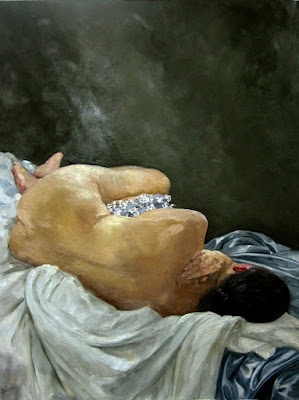Canadian painter Prudence Heward was an audacious post-Impressionist, and so much more.
 |
|
Rollande, 1929, Prudence Heward, courtesy National Gallery of Canada.
|
When I first saw the painting above, I laughed aloud. I was painting badly, my nose dripping horribly. Young Rollandeperfectly echoed my mood. Kudos to the aficionado who texted it to me.
Rollande’s discontent is epitomized by her pink work apron. It is the initial focus of the painting and must have been loathsome to a girl with ambition. She stands, hands on hips, separated by a fence from the Quebec farm that is her lot in life. Even her posture is confrontational. She may be staring directly at us in the Modernist mode, but hers is no happy face. It’s almost as if we are part of the problem.
Compare her face to Bronzino’s Portrait of a Young Man, c. 1530, and you sense where Prudence Heward is heading. Bronzino’s anonymous poet can stare with unsmiling hauteur and we understand that he is the cock of the walk. But women—especially low-status women—are supposed to be cheerful.
 |
|
Sisters of Rural Quebec, 1930, Prudence Heward, courtesy Art Gallery of Windsor
|
Rollande also modelled for Heward’s Sisters of Rural Quebec, 1930. The younger girl is her sister, Pierrette. The composition is a brilliant, complex slash of diagonal and vertical lines. It serves to further isolate the sisters, both from each other and from us. Not only are their faces stark and emotional, but note the sunflower at the bottom left corner. It’s in darkness, a mute testimony to their ‘real’ life on the farm.
 |
|
Apple Tree (Study for Portrait of Ellen), c. 1935, Prudence Heward, courtesy National Gallery of Canada.
|
“I think that of all the arts in Canada painting shows more vitality and has a stronger Canadian feeling,” Heward wrote in 1942. At that time, Canadian painting had reached a brilliant maturity, separate from its American and British siblings. It was uniquely reflective of the country, its circumstances, its ethos and its pride.
 |
|
Anna, c. 1927, Prudence Heward, courtesy National Gallery of Canada. She looks as if she’s fallen in the snow.
|
Prudence Heward was primarily known as a figure painter, although I’ve included a few of her landscapes as well. She was not limited by traditional Québécois expectations herself. Rather, she was born in Montreal to a large, affluent family who supported her artistic inclinations.
During World War I she served with the Red Cross in England. Returning to Canada, she resumed painting, joining the modernist Beaver Hall Hill Group. Her first exposition was in 1924; her first solo show in 1932.
 |
|
Farmhouse and Car, c. 1933, Prudence Heward, courtesy National Gallery of Canada.
|
In 1925, she went to Paris on scholarship, studying at the Académie Colarossi. Her work was profoundly influenced by the monumentality and color sensitivity of Paul Cézanne, Henri Matisseand Henri Rousseau.
In Paris, she met her lifelong friend, Isabel McLaughlin. Together, they returned to Paris in 1929 and took sketching classes at the Scandinavian Academy. Heward traveled with McLaughlin and other artist friends throughout her life. They visited the Heward summer home near Brockville on the Saint Lawrence, northern Ontario, the Laurentians and Bermuda. In 1933, Prudence Heward co-founded the Canadian Group of Painters, the successor group to the Group of Seven.
 |
|
The Immigrants, Prudence Heward, 1929, private collection, Toronto
|
A serious car accident in 1939 was the beginning of the end of her career. She continued to paint until 1945, when her health problems forced her to give up her brush. Primary was her worsening asthma. She was seeking treatment for it in Los Angeles when she died in 1947 at the age of fifty. It was an unfortunate, untimely loss for Canadian painting.

